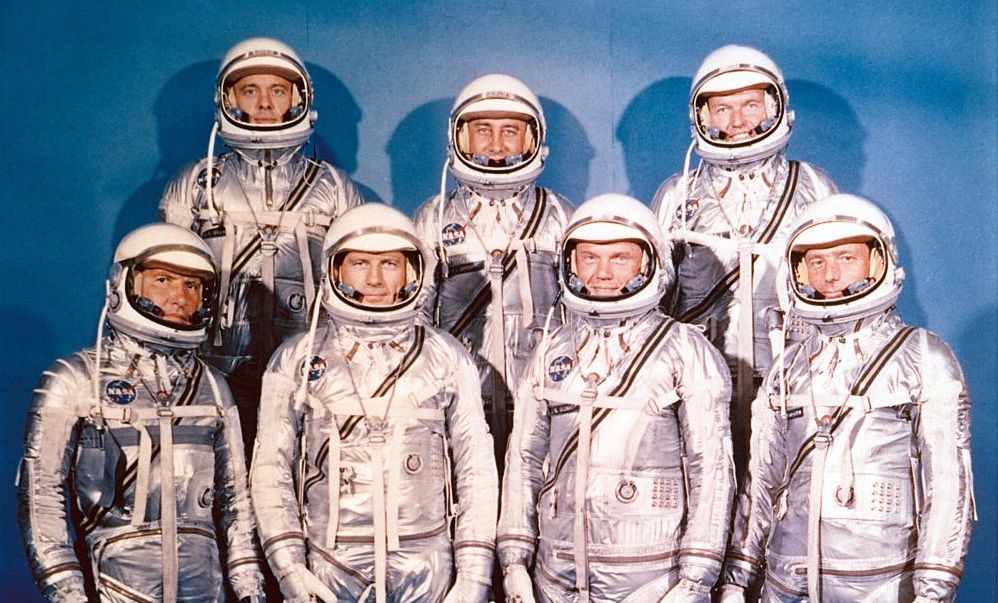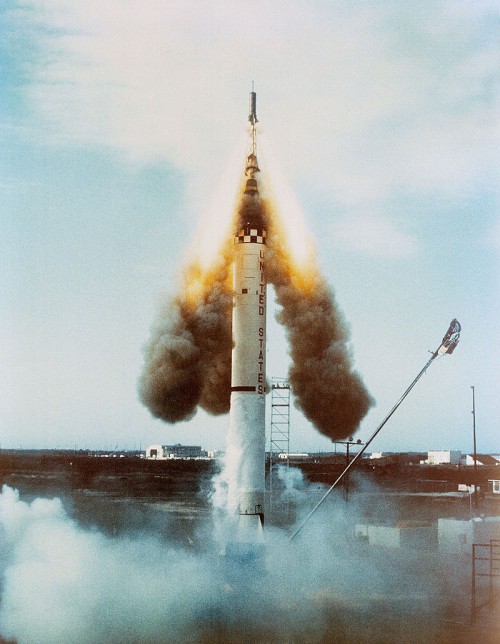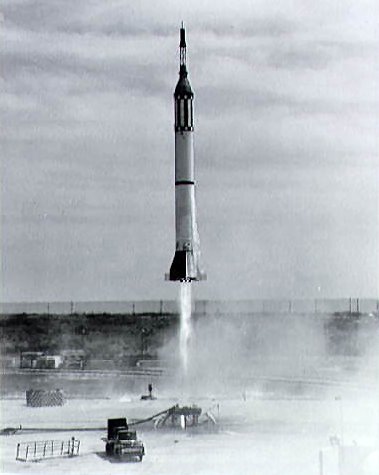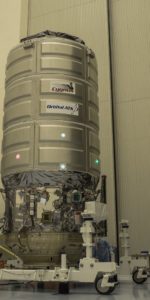
Fifty-five years ago, next week, on 24 March 1961, the final unpiloted mission of a Mercury-Redstone capsule-booster combination roared into space, ahead of the launch of America’s first astronaut. As outlined in yesterday’s AmericaSpace history article, it was conducted in response to numerous technical malfunctions on previous flights. Despite its necessity, the Mercury-Redstone Booster Development (MR-BD) was regarded in some quarters as effectively causing the United States to lose the race to put a man into space ahead of the Soviet Union. Eighteen days after MR-BD cleared the Mercury-Redstone as fully capable of carrying a human pilot, Russia’s Yuri Gagarin became the first person in history to depart the Home Planet and enter space. It left many within NASA furious, not least astronaut Alan Shepard. “We had ’em by the short hairs,” he once growled, “and we gave it away!”
In the months before this pivotal event, a series of unmanned test flights of the Mercury-Redstone were undertaken by NASA to evaluate modifications made to the converted U.S. Army Medium-Range Ballistic Missile (MRBM) and to the capsule itself. The first, named Mercury-Redstone 1 (MR-1), was intended to put the abort system fully through its paces, in addition to achieving the kind of velocities—around Mach 6.0—that a suborbital-flying astronaut would experience and demonstrating the ability of the capsule to separate satisfactorily from the rocket. A launch attempt on 7 November 1960 was scrubbed due to low hydrogen peroxide pressures in the capsule’s thrusters and was rescheduled for the 21st.
At 8:59 a.m. EST, ignition occurred on time, but as the Redstone made to leave the pad, a shutdown signal was initiated. The thrust buildup was sufficient for the rocket to rise 4 inches (10 cm), before it settled back onto its pedestal. However, the shutdown signal had caused the Launch Escape System (LES) tower to fire, producing huge clouds of smoke which momentarily hid the Redstone from view. Flight Director Chris Kraft, watching the proceedings, was astonished by the tremendous acceleration, thinking it to be the actual liftoff … “but then the smoke cleared and the missile was still there!” Mercury astronaut Wally Schirra described the fiasco as “a memorable day, especially for someone who likes sick jokes.”

The rocket swayed slightly, but remained upright and did not explode. Worryingly, though, the LES—which shot three-quarters of a mile (about 1.2 km) high and landed 1,200 feet (360 meters) from the pad—had not pulled the Mercury capsule clear of the Redstone. As the shocked flight controllers watched, the drogue parachute popped out of its nose, followed by the main canopy and lastly, accompanied by a green cloud of marker dye, an auxiliary chute. All three fluttered pathetically onto the pad. The rocket, meanwhile, was left alone as its liquid oxygen and high-pressure nitrogen was drained, its fuel and hydrogen peroxide tanks emptied, its circuits deactivated, and its destruct arming devices removed. (Initial suggestions to relieve the pressurised propellant tanks by shooting holes in them with a rifle, thankfully, were squashed.)
“The press had a field day,” Kraft recalled later. “It wasn’t just a funny scene on the pad. It was tragic and America’s space program took another beating in the newspapers and in Congress.” Investigators would find that the shutdown had been triggered by a “sneak” circuit, created when two electrical connectors in a two-pronged booster tail plug separated in the wrong order.
According to NASA’s investigation report, the failure of the Mercury capsule to separate from the booster was because G load sensing requirements had not been met. Ordinarily, after an engine cutoff, a 10-second timer was initiated and, upon its expiry, was supposed to separate the capsule if acceleration was less than 0.25 G. However, MR-1 had settled back onto the pad before the timer expired and the G-switch, sensing 1 G of acceleration, blocked the separation signal. On-board barostats, meanwhile, properly sensed that the rocket’s altitude was less than 1.8 miles (3 km) and therefore activated the parachutes. “Once we realized that the capsule had made the best of a confusing situation and had gone on to perform its duties just as it would have on a normal flight,” John Glenn said later, “we were rather proud of it.” However, to avoid a recurrence, a ground strap was added to maintain grounding of the vehicle during all umbilical disconnections and changes to the electrical network distributor prevented a cutoff signal from jettisoning future LES towers prior to 130 seconds after liftoff.
The undamaged spacecraft would be recycled and reused on the MR-1A flight just four weeks later. Despite some difficulties with a leakage in the capsule’s high-pressure nitrogen line and a faulty solenoid valve in its hydrogen peroxide system, the mission was launched successfully at 11:15 a.m. EST on 19 December. Thankfully, the abort system performed as advertised, although a malfunction of the velocity integrator caused the Redstone’s velocity cutoff to occur 256 feet per second (78 m/sec) higher than planned, thus boosting the capsule 6 miles (9.6 km) above its intended 127-mile (205 km) altitude. Accelerations during re-entry were correspondingly more severe and high tail winds during the final portion of the flight led to MR-1A splashing into the Atlantic 20 miles (32 km) further downrange than anticipated. The source of the velocity integrator problem was traced to excessive torque against the pivot of the accelerometer, caused by electrical wires; five of these were replaced and a softer wire material was implemented. This solved the problem, as the chimpanzee Ham’s MR-2 flight at the end of the following month would demonstrate.
Ham was launched at 11:54 a.m. EST on 31 January 1961. His home for the 16-minute mission boasted an environmental control system, live retrorockets, a voice communications device, and the accordion-like pneumatic landing bag. The latter was attached to the heat shield and shortly before splashdown, the pair would drop 4 feet (1.2 meters), filling with air to help cushion MR-2’s impact. In the water, the landing bag and heat shield were intended to serve as an anchor, keeping the spacecraft upright.

Ham’s liftoff was successful, although his Mercury capsule, programmed to travel 114 miles (183 km) into space and 290 miles (468 km) downrange of the Cape, actually flew 41 miles (67 km) higher and 124 miles (200 km) further downrange than intended. The chimp experienced 6.5 minutes of weightlessness and endured 14.7 times the force of normal terrestrial gravity at one point during his re-entry. He survived and seemed to be in good spirits, despite having to wait for several hours before being picked up by the dock landing ship Donner. After splashdown, his heat shield had skipped on the water, bounced against the capsule’s base and punched two holes in the pressure bulkhead. As MR-2 capsized, the open cabin pressure relief valve let in yet more seawater. By the time he was rescued, it was estimated that there was around 800 pounds (360 kg) of seawater inside the capsule. Ham, however, seemed in good spirits, gobbling down a pair of apples and half an orange on the recovery ship’s deck.
Post-flight analysis would reveal that the Redstone’s mixture ratio servo control valve failed in its full-open position, causing early depletion of the liquid oxygen supply; consequently, the propellant consumption rate increased, the turbopump ran faster and led to higher thrust, an earlier-than-scheduled engine shutdown and the inadvertent “abort” of the MR-2 spacecraft. In the wake of Ham’s flight, the reliability of the Mercury-Redstone combination was reassessed, culminating in an estimated probability of success at somewhere between 78-84 per cent. However, many components had been designed in line with highly conservative parameters and it was considered more likely that the reliability of the system was about 88 percent for launch and 98 percent for the survival of an astronaut.
These assurances were confirmed by one final test prior to Shepard’s mission: the Mercury-Redstone Booster Development (MR-BD) flight, launched on 24 March 1961. Although it was doubtful that any of the problems experienced on either MR-1A or MR-2 would have endangered Shepard, had he been aboard, the focus upon reliability meant that all significant outstanding modifications to the Redstone had to be dealt with. Moreover, a human launch would not be attempted until all parties were satisfied that the vehicle was ready to go.
As a result, Alan Shepard’s Freedom 7 mission was fatefully postponed until no sooner than 25 April 1961. This caused the United States to lose out to the Soviet Union in launching the first man into space. Meanwhile, the MR-BD test was perfect: the Redstone flew flawlessly, with its thruster control servo valve’s closed position adjusted to 25 percent open and flight sequencer timer changes prevented a recurrence of the problems on Ham’s flight. Control maneuvers were executed to evaluate the effect of higher-than-normal angles of attack, confirming that the Redstone could withstand additional aerodynamic loads. No attempt was made to separate rocket and capsule and they splashed down together, some 8.5 minutes after launch, before sinking to the bottom of the Atlantic.
The success of MR-BD had cleared the way for MR-3, which would carry Shepard on a mission which was historic in the sense that it represented America’s first foray into space. However, the frustration at having been unable to launch before the Soviets—even on a suborbital flight—lingered for some time to come. It is purely academic today, of course, but the perceived “second-place” of the United States in the space race undoubtedly led to President John F. Kennedy’s decision to commit his nation to a piloted lunar landing before the end of the 1960s. And the initial failure of America to catch up with the Soviets in the first half of the decade was countered by a spectacular series of long-duration Gemini missions, which, ultimately, enabled humans to depart the gravitational “well” of low-Earth orbit for the first time and reach our closest celestial neighbor.
This is part of a series of history articles, which will appear each weekend, barring any major news stories. Next week’s article will focus on the 20th anniversary of STS-76, which accomplished the third shuttle-Mir docking and delivered U.S. astronaut Shannon Lucid for a multi-month stay aboard the orbital station.
Be sure to “Like” AmericaSpace on Facebook and follow us on Twitter: @AmericaSpace





